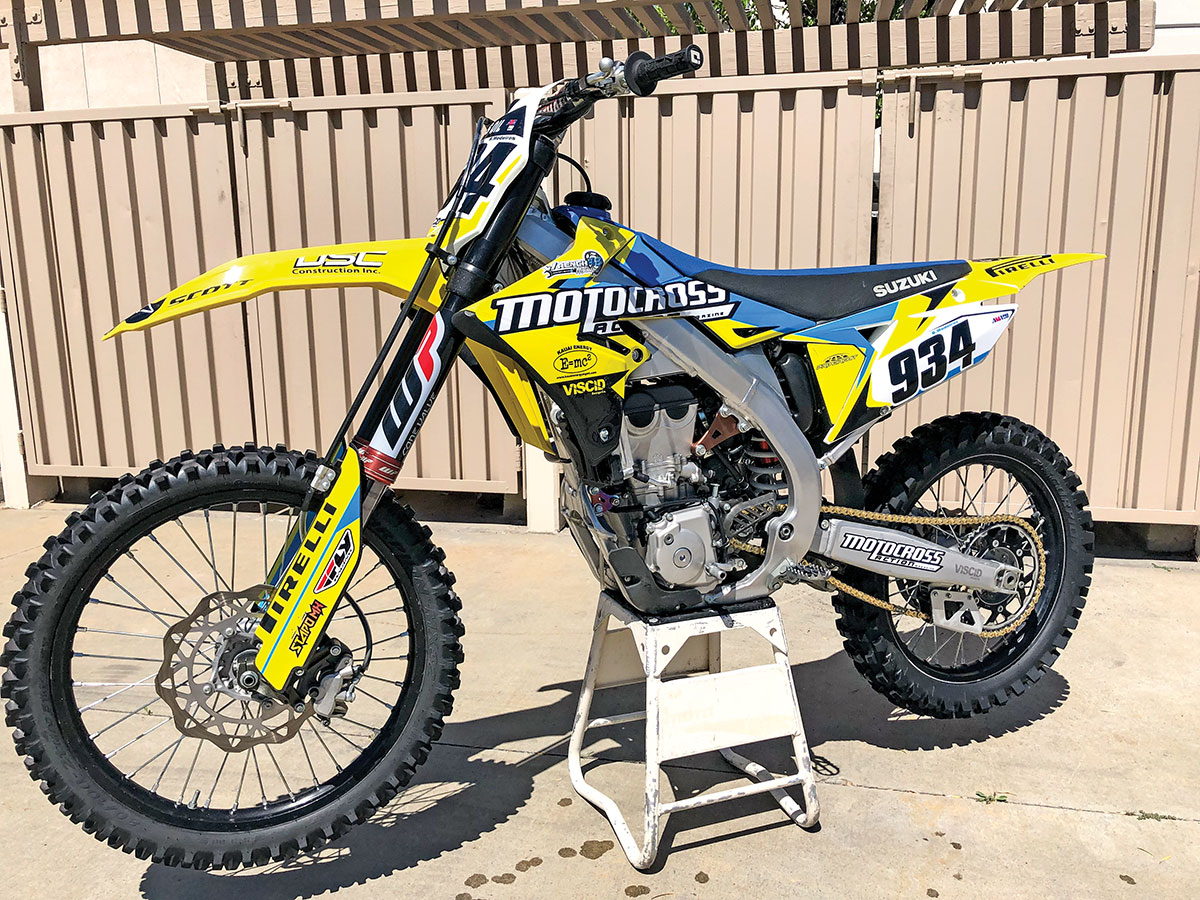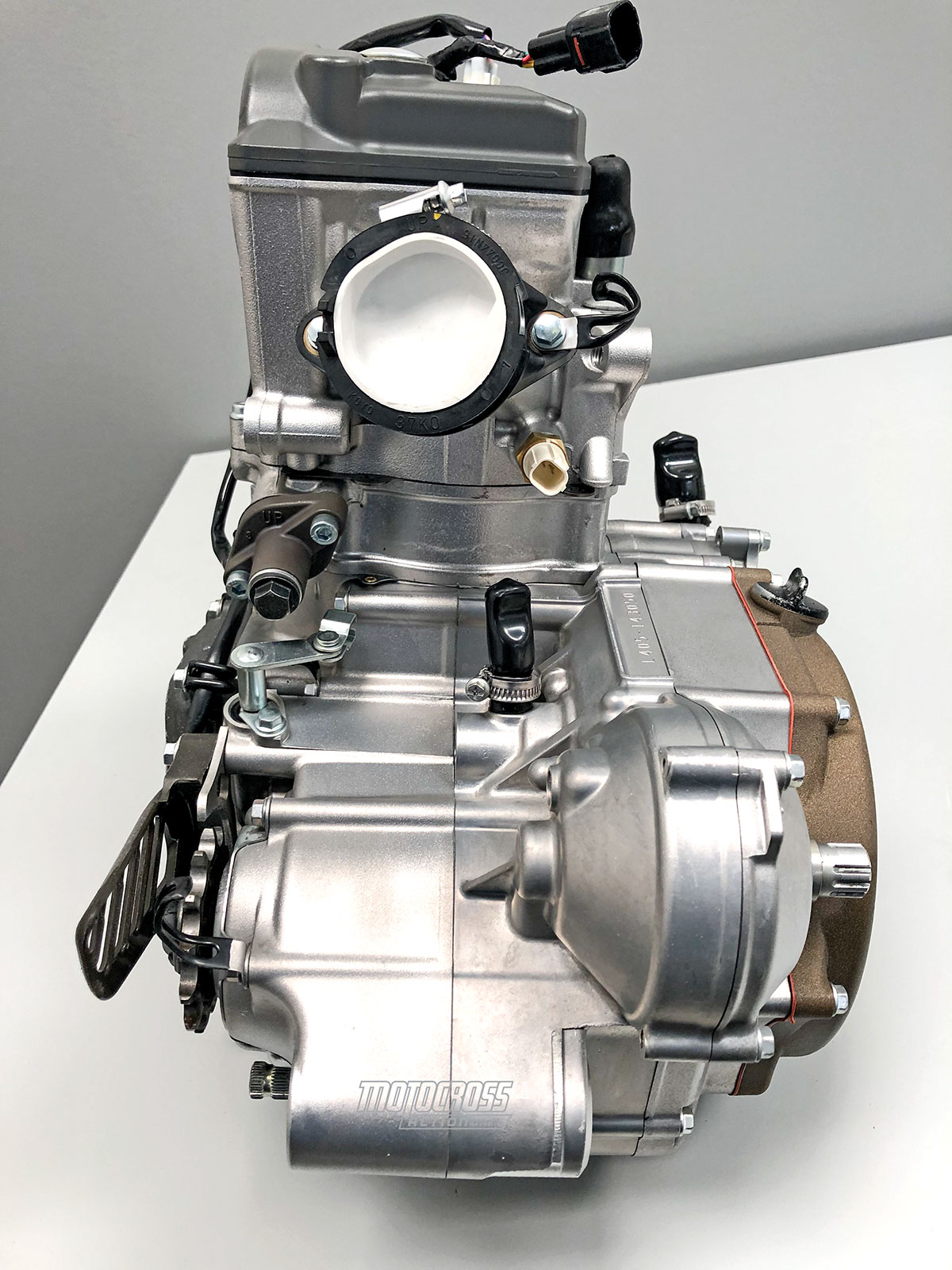40-HOUR 2019 SUZUKI RM-Z450 MOTOCROSS FRESHEN UP
By Brian Medeiros
What’s up, Motocross Action readers? Test rider Brian Medeiros here. I have been spending a lot of time on MXA’s 2019 RM-Z450. Everything has been in proper working order, and since we just hit the 40-hour mark, we decided to take an in-depth look at the engine and inspect all the parts and pieces to see what it really needs at 40 hours. We took our RM-Z to Anthony Di Basilio at Wrench 42 Motorsports in Murrieta, California. Anthony was a long-time employee of KTM North America and recently left the orange team to start his own motorcycle shop that offers full chassis, engine and suspension services.

WHAT PARTS DID WE NEED AT 40 HOURS? First to go were the chain slider and the chain guide rubber buffer. We ran the stock chain slider and chain guide for all 40 hours on this bike. The chain guide was down to the metal, and the slider was almost down to the swingarm. We recommend keeping an eye on these parts, not only for safety’s sake, but because letting them go too long will cause your chain to cut into your swingarm, resulting in some expensive damage. We replaced both with OEM Suzuki parts.
Footpeg springs. Our footpeg springs were worn out, and once they were, they no longer had any pressure on the footpegs. This made the footpegs feel loose in the mounts and rattle like crazy when our feet were off them. We replaced both footpeg springs with OEM Suzuki springs.
Front and rear brake pads. We had replaced the front brake pads a couple of times already, but we didn’t have to replace the rear pads until just short of 40 hours.
Piston kit. Although our RM-Z was still running well at 40 hours, we decided that since the engine was coming out of the frame to be totally inspected, we would have Anthony of Wrench 42 Motorsports do a full tear down. Once the engine was apart, we saw that the piston was still in good shape and showed no signs of sucking any dirt. The bottom end was also in great shape. Anthony gave the cases a good cleaning and reassembled the engine with an OEM Suzuki piston and gasket kit. Note that the OEM Suzuki piston comes with a DLC-coated wrist pin.
Clutch. The MXA test riders have averaged 10 hours on the OEM steel and fiber clutch plates. The clutch basket was still in good shape, but we put a new set of clutch plates in it. Of course, we had test riders who could eat up an RM-Z clutch in two races. We put plates and fibers in when we had the engine rebuilt.

WHAT DOES A FULL BIKE REBUILD SERVICE INCLUDE AT WRENCH 42 MOTORSPORTS? Every bike that comes into former KTM mechanic Anthony Di Basilio’s Wrench 42 Motorsports shop for a rebuild gets a good wash and the plastics removed before being moved over to the work bay to be completely torn down and inspected.
Parts list. Once the inspection process is complete, the guys get a parts list together of everything that will be needed to get the bike back in tip-top shape.
Engine tear-down. If the customer wants a full engine rebuild, the engine is taken apart and every part of the engine is inspected to ensure it is in proper working order. If it’s not, any worn parts will be replaced.
More cleaning. Once the engine is town down, the parts and bolts get cleaned in the solvent tank, and the cases are vapor blasted for a factory-look finish. Vapor blasting the cases can only be done if the engine is getting completely torn apart so it is possible to make sure there is no water left in the engine. The frame and swingarm also get cleaned at this time.
Assembly of the engine. Once everything is cleaned and inspected, the assembly process begins. With all necessary new parts and gaskets, the engine gets completely rebuilt using the manufacturer’s specifications to ensure proper function of the engine.
Chassis. With the engine now completely rebuilt, it’s time to replace (if needed) and re-grease all pivot points of the motorcycle. Once everything is greased, the assembly of the chassis begins using manufacturer-recommended torque specs to ensure everything is in safe and proper working order.
First heat cycle. With the bike now completely assembled, fluids leveled off and every nut and bolt double checked, it’s time for the engine to be started and run through its first heat cycle. This is a static run test just to gently break in the piston, rings and bearings. There is no load on the Suzuki RM-Z450 engine.
Final stage. Once the first heat cycle is complete, the bike is taken back to the work bay and every nut and bolt is checked for the umpteenth time.
Call the customer. At this stage, the bike’s owner is called to pick up his bike, and he is given instructions about what to watch for, as well as detailed break-in instructions. And, of course, the customer is handed the bill before he rolls the bike out of the shop.

WHAT DOES THE FULL BIKE BUILD SERVICE COST AT WRENCH 42 MOTORSPORTS? $1500 plus parts. For more information, go to www.wrench42motorsports.com, phone (951) 698-3692 or e-mail them at [email protected].
DOES WRENCH 42 MOTORSPORTS OFFER OTHER SERVICES? Yes, they do. They do complete engine rebuilds starting at $300, chassis service for $500 and suspension setup (through TBT Suspension).
WHAT AFTERMARKET PARTS AND PIECES DID MXA USE ON ITS RM-Z450? In stock trim, the 2019 RM-Z450 needs a little help to be race ready. The chassis has a very rigid feel, and there is the traditional Suzuki instability at high speeds. Some of this is just part of owning a Suzuki; however, the BFRC shock design has very limited adjustability, which makes it hard to dial in for a wide variety of track conditions. The engine also lacks the “get up and go” of the Honda CRF450; the broad, torquey feel of the KTM; or the purr of the Yamaha YZ450F. These are the aftermarket parts that we added to our RM-Z to make it competitive against the rest of the field, as well as give it a little facelift.
Motor mounts. We used FCP Racing titanium motor mounts. They retail for $399 and try to mimic the motor mounts that the JGR team uses.
Exhaust system. Pro Circuit T-6 stainless steel full exhaust system. The stainless system retails for $818.96.
Graphics. Viscid Design Co. Our graphics cost $150 for the gloss finish or $160 for the matte finish.
Suspension. We started testing WP Cone Valve forks and Trax shocks back when the 2018 Suzuki RM-Z450 first came out. We spent more time on the WP suspension throughout 2018 and all of 2019. The WP Trax shock solves all the problems that seem to be inherent in the stock Showa BFRC rear shock. The WP XACT cone-valve spring fork has been our go-to fork of choice on the Honda CRF450, Kawasaki KX450 and Suzuki RM-Z450. The WP XACT spring forks are $3500, and the WP Trax shock is $2500.





Comments are closed.